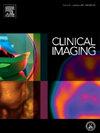机器学习衍生的nomogram和生物标志物在预测侧特异性前列腺外展中的比较分析:初步发现
IF 1.5
4区 医学
Q3 RADIOLOGY, NUCLEAR MEDICINE & MEDICAL IMAGING
引用次数: 0
摘要
目的本研究旨在评估和比较使用术前生物标志物预测前列腺癌侧特异性前列腺外展(EPE)的nomogram和machine learning (ML)技术的性能,EPE与预后不良和早期复发有关。准确的术前预测可以指导临床决策,提高治疗效果。材料与方法回顾性分析108例行根治性前列腺切除术的前列腺癌患者的资料。收集临床、影像学和基因组数据,包括PSA密度、ISUP活检分级、阳性活检芯比例、68Ga-PSMA-11 PET、MRI和破译基因组分类器(DGC)评分。使用逻辑回归(LR)和极端梯度增强(XGBoost)算法建立预测模型,并结合这些输入的不同组合。采用ROC曲线下面积(AUC)评价模型性能。结果患者中位年龄为61.5岁。在大多数生物标志物组合中,XGBoost的表现优于LR。PET+DGC模型AUC最高(XGBoost为0.85),PET+MRI +DGC次之(0.83)。XGBoost始终比LR获得更高的auc,特别是对于DGC和组合输入模型。仅pet预测比仅基于MRI或基因组学的预测更强,但多模态组合显著提高了预测准确性。这是首次将PSMA-PET、MRI和基因组学整合到基于ml的诺图模型中,用于侧特异性EPE预测。XGBoost模型表现出卓越的预测能力,特别是在PET和DGC结合使用时。这些发现突出了多生物标志物、机器学习方法在改善术前风险分层和支持个性化治疗计划方面的潜力。进一步的研究将在更大的队列中验证该模型。本文章由计算机程序翻译,如有差异,请以英文原文为准。
Comparative analysis of machine learning-derived nomogram and biomarkers in predicting side-specific extraprostatic extension: Preliminary findings
Aim
This study aimed to assess and compare the performance of nomograms and machine learning (ML) techniques using preoperative biomarkers for predicting side-specific extraprostatic extension (EPE) in prostate cancer, which is linked to poor outcomes and early recurrence. Accurate preoperative prediction can guide clinical decisions and improve treatment.
Materials and methods
A retrospective analysis was conducted using data from 108 prostate cancer patients undergoing radical prostatectomy. Clinical, imaging, and genomic data were collected, including PSA density, ISUP biopsy grade, fraction of positive biopsy cores, 68Ga-PSMA-11 PET, MRI, and Decipher Genomic Classifier (DGC) scores. Predictive models were built using logistic regression (LR) and extreme gradient boosting (XGBoost) algorithms, incorporating different combinations of these inputs. Model performance was evaluated using area under the ROC curve (AUC).
Results
The median patient age was 61.5 years. XGBoost outperformed LR across most biomarker combinations. PET+DGC models had the highest AUC (0.85 for XGBoost), followed by PET+MRI + DGC (0.83). XGBoost consistently achieved higher AUCs than LR, particularly for DGC and combined input models. PET-only predictions were stronger than those based solely on MRI or genomics, but multi-modal combinations significantly enhanced prediction accuracy.
Conclusion
This is the first study to integrate PSMA-PET, MRI, and genomics in ML-based nomogram models for side-specific EPE prediction. XGBoost models demonstrated superior predictive power, especially when combining PET and DGC. These findings highlight the potential of a multi-biomarker, machine learning approach to improve preoperative risk stratification and support personalized treatment planning. Further studies will validate this model in larger cohorts.
求助全文
通过发布文献求助,成功后即可免费获取论文全文。
去求助
来源期刊

Clinical Imaging
医学-核医学
CiteScore
4.60
自引率
0.00%
发文量
265
审稿时长
35 days
期刊介绍:
The mission of Clinical Imaging is to publish, in a timely manner, the very best radiology research from the United States and around the world with special attention to the impact of medical imaging on patient care. The journal''s publications cover all imaging modalities, radiology issues related to patients, policy and practice improvements, and clinically-oriented imaging physics and informatics. The journal is a valuable resource for practicing radiologists, radiologists-in-training and other clinicians with an interest in imaging. Papers are carefully peer-reviewed and selected by our experienced subject editors who are leading experts spanning the range of imaging sub-specialties, which include:
-Body Imaging-
Breast Imaging-
Cardiothoracic Imaging-
Imaging Physics and Informatics-
Molecular Imaging and Nuclear Medicine-
Musculoskeletal and Emergency Imaging-
Neuroradiology-
Practice, Policy & Education-
Pediatric Imaging-
Vascular and Interventional Radiology
 求助内容:
求助内容: 应助结果提醒方式:
应助结果提醒方式:


